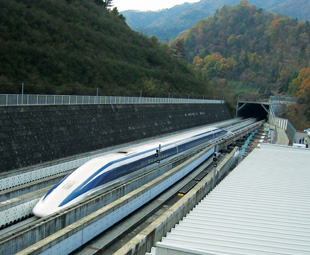Hydrail the green transport solution?

The hydrail concept promises cleaner rail travel thanks to a new breed of hydrogen-powered train. With Japan, the US, China and the EU all having announced research into this relatively new technology, ROWAN WATT-PRINGLE examines the potential for a new lean, green transport sector.
“Hydrail is simply rail that uses hydrogen to carry energy onboard,” says Stan Thompson, director of the seventh annual International Hydrail Conference and chairman of the Hydrogen Economy Advancement Team (HEAT). “This means is that intermittent renewable energy sources, including wind, tide and sunlight can be harnessed to power something running on exact schedules, such as a train,” he continues.
“The primary advantage of hydrail is that it runs on ordinary track and the only new infrastructure needed is trains and/or locomotives and a very few fuelling points along select lines using the technology.”
Dr Alistaire Miller, researcher emeritus at Atomic Energy of Canada’s Chalk River Laboratories and also one of the fathers of the hydrail concept, believes hydrail to be an important environmental advancement: “For AECL, hydrail is a concept that fits into the broad perspective of future energy supply for the planet,” he says. ”An 80% reduction in current global CO2 emissions is needed to stabilise greenhouse gas (GHG) levels – a task that is made more difficult by the rapid expansion in energy demands from emerging economies.”
Miller explains that as electricity supply continues to grow, CO2 emissions from fossil-fuel-fired electricity generation need to be sharply curtailed, so it is essential that non-emitting technologies penetrate new areas of use.
Why hydrogen?
“The environmental advantage of hydrogen at the point of use is significant compared to diesel, as only water is emitted as exhaust gas, providing significantly lower well-to-wheel GHG emissions than both diesel and electric power in many countries,” says Andreas Hoffrichter, who is conducting research at the University of Birmingham leading his PhD on “The Utilisation and Penetration of Hydrogen to Power Railway Vehicles”.
 According to Miller, hydrogen converted from electricity is preferable to extracting the gas from hydrocarbons, because the latter “is not useful unless the co-product, CO2, can be sequestered by carbon capture and storage (CCS) – a dubious and as yet unproven technology”.
According to Miller, hydrogen converted from electricity is preferable to extracting the gas from hydrocarbons, because the latter “is not useful unless the co-product, CO2, can be sequestered by carbon capture and storage (CCS) – a dubious and as yet unproven technology”.
“AECL has studied the economics of making this conversion by conventional electrolysis and found that the economics are favourable if off-peak electricity is used,” says Miller. “A combination of electricity from nuclear and wind (using real wind data) was shown to be feasible. Not only does this approach produce a competitive fuel source, it also provides a useful way of storing electrical energy.”
Hoffrichter says: “Hydrogen-powered vehicles, like diesel power, have the advantage of being autonomous and can therefore provide flexibility in railway networks that are either partially electrified or not electrified at all.”
Thompson also sees hydrail as the obvious solution to what he stresses is a dead technology – electric rail is “rolling toward a train wreck and no-one is taking any notice”. He says that merely the incremental electrification of just one mile (1,6 km) of track in the US is likely to cost US$12 million, with the cost heading the same way as copper’s – up.
“This means that if the US diverted the cost of electrification for just 160 km of planned High Speed Train electrification, we’d have US$1,2 billion in R&D to spend on developing wireless alternatives.”
Thompson’s argument is a convincing one, especially given the number of alternatives, ranging from battery multidiesel hybrids and the conversion of diesel motors to spark-ignition hydrogen engines, to the burning of anhydrous ammonia (NH).
This begs the question, he adds, “Do we really want to add a large, real-time commuter-hour load when we can electrolyse hydrogen during off-peak hours?”
Hydrogen vs biofuels
“Biofuels might make a contribution, but the technology is less mature than for electricity or hydrogen,” says Miller. “Added to this, what has been deployed to date is of mixed value. Ethanol from sugar cane, for example, is mostly positive while ethanol from maize can be shown to be totally misguided if one considers nitrous oxide emissions from growing maize. For this reason alone, the immediate focus should be on electricity and hydrogen.”
Thompson agrees: “In my opinion, hydrogen from off-peak nuclear power is a much better bet than any biofuel production because the heavy transportation demands of a nation can’t be held hostage to droughts, floods or other natural catastrophes.”
Hydrail initiatives around the world
“The EU is rather strapped for cash at the moment, but the UK has looked closely at hydrail as a non-diesel way to ‘electrify’ lines without the multimillion pound-per-mile capital cost,” says Thompson.
There are projects underway across Europe, though: “Since 2006, Denmark has been looking at a wind-to-hydrogen commuter rail line from Vemb to Thyborön, while Ferrocarriles de Vía Estrecha (FEVE), the state-owned Spanish railway company, is actively working on a narrow-gauge hydrail train to connect the northern provinces,” he adds.
Hoffrichter emphasises that hydrail vehicles are still very much in the development phase. “I am not aware of any large-scale implementation plan for hydrail vehicles at present and more prototypes for specific railway services are needed.”
According to Thompson, Japan built and successfully tested two hydrail trains, but never put them into revenue service. He believes that the trains could have brought huge transport relief to the country during the rolling brownouts experienced in the wake of the tsunami earlier this year.
In November, China also recognised the potential of hydrogen fuel with the announcement of the superpower’s first hydrail – termed the “new energy fuel cell train”. The train uses hydrogen fuel cells as well as an advanced permanent-magnet synchronous motor and frequency converter, which conserves 10% to 20% of integrated energy. It also has many possible applications leading to economic and environmental benefits in sectors ranging from railways to mining.
 This was swiftly followed by a strategic alliance between Bombardier Transport’s German division and the Chinese Ministry of Railways. At the time of the announcement Bombardier’s president and chief operating officer, André Navarri said: “China has a clear vision of the critical role rail must play in sustainable economic development, and is making the strategic investments necessary to ensure that vision is realised.” He added that the country was “selecting state-of-the-art technologies to build the most advanced rail network in the world”.
This was swiftly followed by a strategic alliance between Bombardier Transport’s German division and the Chinese Ministry of Railways. At the time of the announcement Bombardier’s president and chief operating officer, André Navarri said: “China has a clear vision of the critical role rail must play in sustainable economic development, and is making the strategic investments necessary to ensure that vision is realised.” He added that the country was “selecting state-of-the-art technologies to build the most advanced rail network in the world”.
“We are pleased to have worked closely with the Chinese Ministry of Railways (MoR) and our local partners in the past and look forward to working together in the development of new, game-changing technologies,” Navarri concluded.
The EU, Japan and US are probably at the same stage of setting up hydrogen supply infrastructure, according to Tarun Huria, a PhD student researching land vehicles and transport systems at the University of Pisa in Italy. Like Bombardier, Alsthom, Hitachi, Toshiba, Mitsubishi, Siemens and ABB are all gearing up to manufacture hydrail vehicles in the near future, he said.”
The future of hydrail
According to Huria, “Hydrail technology has been successfully demonstrated through one-off projects in Japan, Canada and the US. Japan is at the forefront of the technology development, followed by America, while the EU also has some demonstration projects in the pipeline.”
However, Huria cautions that there are still prerequisites before hydrail technology can be adopted. “The relevant hydrogen manufacture and distribution infrastructure must be in place and people need to be made aware that it is a safe technology, while it must be shown to be economically viable.”
Miller believes that the effective deployment of hydrogen is key: “With the rapid development of battery technology and the existence of grids to deliver electricity, it is likely that light vehicles will mostly use electricity and there will be little incentive to provide a new, universal fuel distribution grid for hydrogen.”
Because of this, he sees a role for hydrogen fuelling in places where there is heavy-duty usage with limited roaming and where the volume of fuel is unimportant, adding, “Local rail networks are particularly suited – hence the Hydrail concept.
“The transition to hydrail seems imminent, but in the near-term, the railways will probably first adopt hybrid-electric technology and then, as the fuel cell costs reduce, shift to hydrail.”
But hydrail could be just the start, as Miller concludes: “Other applications of hydrogen could follow hydrail – perhaps ships, large trucks and ultimately planes. Of great interest for the latter is the low weight of the fuel, as well as the cooling effect of vaporising liquid hydrogen, which can be applied to reduce drag by cooling the leading edges of wings. But despite this, Hydrail is the obvious place to start.”
• Originally published on www.railway-technology.com



